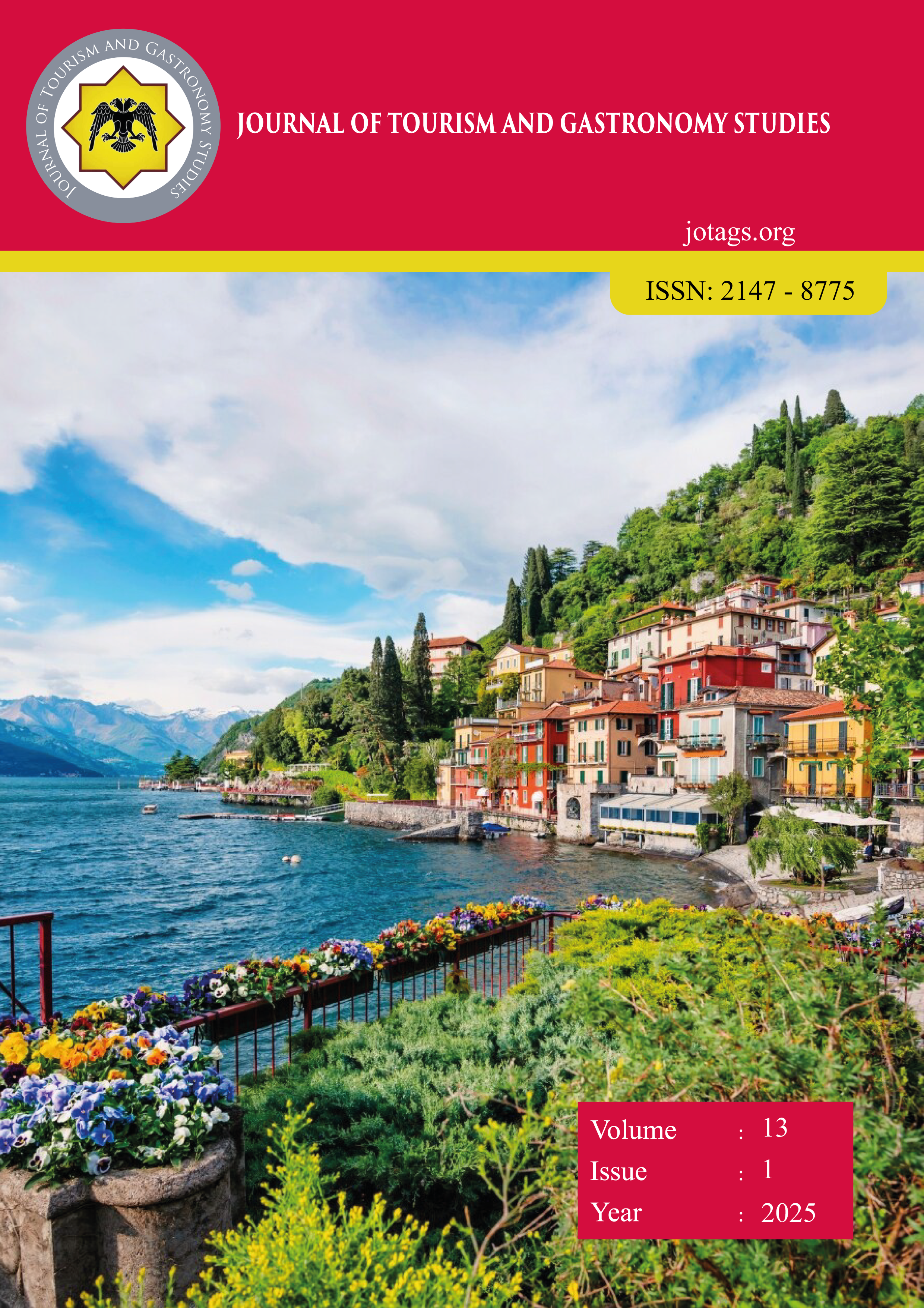Kestane Unu Katkısının Ekşi Mayalı Simitlerin Besleyici ve Fonksiyonel Özelliklerine Etkisi (The Effect of Chestnut Flour Incorporation on the Nutritional and Functional Properties of Sourdough Simit)
DOI:
https://doi.org/10.21325/jotags.2025.1575Keywords:
Chestnut flour, Functional food, Simit, SourdoughAbstract
Simit holds a significant place in Turkish cuisine, exhibiting diversity in its ingredients and production methods. This study aims to investigate the effects of chestnut flour and sourdough on the nutritional value and functional properties of traditional simit. For this purpose, chestnut flour was substituted at different ratios (5%, 10%, 15%, 20%) with wheat flour, and the produced simit samples were subjected to chemical, physical, and sensory analyses. Sensory evaluations were conducted with a consumer panel of 20 participants to determine overall acceptability levels. The data were analyzed using statistical software, employing ANOVA and Tukey's multiple comparison tests. Chemical analyses revealed that as the chestnut flour content increased, ash, total fat, and dietary fiber levels rose, whereas moisture and protein contents decreased. Color analysis indicated that chestnut flour addition reduced brightness (L*) and yellowness (b*) values while increasing redness (a*) values. Textural analysis results showed that chestnut flour incorporation did not significantly affect hardness, chewiness, and springiness; however, it led to a decrease in cohesiveness and resilience. Sensory evaluations confirmed that all simit samples were generally acceptable. In conclusion, the study determined that chestnut flour enhances the nutritional value of sourdough simit and contributes to a darker color. This study presents an approach that offers valuable insights to the food industry regarding the use of innovative ingredients to improve the functional and nutritional properties of traditional products.
References
Agama-Acevedo, E., Pacheco-Vargas, G., Gutierrez-Meraz, F., Tovar, J., & Bello-Perez, L. A. (2019). Dietary fiber content, texture, and ın vitro starch digestibility of different white bread crusts. Journal of Cereal Science, 89, 102824. https://doi.org/10.1016/j.jcs.2019.102824
Ahsan, M., Moin, A., Ashraf, H., Kamran, M., Manzoor, I., & Giuffrè, A. M. (2023). Technological, quality and nutritional characteristics of ramen noodles with wheat flour partially substituted by water chestnut flour. Italian Journal of Food Science, 35(4), 136-146. https://doi.org/10.15586/ijfs.v35i4.2423
Alinovi, M., Paciulli, M., Rinaldi, M., Barbanti, D., & Chiavaro, E. (2023). Effect of chestnut flour fortification on physico‐chemical characteristics of gluten‐free fresh pasta. International Journal of Food Science & Technology, 58(6), 3360-3370. https://doi.org/10.1111/ijfs.16309
Arendt, E. K., Ryan, L. A. M., & Dal Bello, F. (2007). Impact of sourdough on the texture of bread. Food Microbiology, 24(2), 165-174. https://doi.org/10.1016/j.fm.2006.07.011
Arshad, M. U., Anjum, F. M., & Zahoor, T. (2007). Nutritional assessment of cookies supplemented with defatted wheat germ. Food Chemistry, 102(1), 123-128. https://doi.org/10.1016/j.foodchem.2006.04.040
Association of Official Analytical Chemists (AOAC). (2016a). AOAC 992.15, Crude Protein in Meat and Meat Products Including Pet Foods (20th edition). Washington, DC: Association of Official Analytical Chemists.
Association of Official Analytical Chemists (AOAC). (2016b). AOAC 991.43, Total, soluble and ınsoluble dietary fibre in foods (20th edition). Washington, DC: Association of Official Analytical Chemists.
Baslar, M., Ozcelik, G. N., & Kiziltepe, E. (2023). A comprehensive review on simit, a turkish traditional food. International Journal of Gastronomy Research. https://doi.org/10.56479/ayed.2023.06281
Bayram, R. (2020). Ziyaretçilerin Sokak Lezzetlerine Yönelik Gastronomik İmaj Algısının Satın Alma Niyetine Etkisi: Antalya Örneği (Yüksek Lisans Tezi). Alanya Hamdullah Emin Paşa Üniversitesi Lisansüstü Eğitim Enstitüsü, Antalya.
Bojarczuk, A., Skąpska, S., Mousavi Khaneghah, A., & Marszałek, K. (2022). Health benefits of resistant starch: A review of the literature. Journal of Functional Foods, 93, 105094. https://doi.org/10.1016/J.JFF.2022.105094
Brochard, M., Correia, P., Barroca, M. J., & Guiné, R. P. F. (2021). Development of a New Pasta Product by the Incorporation of Chestnut Flour and Bee Pollen. Applied Sciences 2021, Vol. 11, Page 6617, 11(14), 6617. https://doi.org/10.3390/APP11146617
Coda, R., Cagno, R. Di, Gobbetti, M., & Rizzello, C. G. (2014). Sourdough lactic acid bacteria: Exploration of non-wheat cereal-based fermentation. Food Microbiology, 37, 51-58. https://doi.org/10.1016/j.fm.2013.06.018
Corsetti, A., Lavermicocca, P., Morea, M., Baruzzi, F., Tosti, N., & Gobbetti, M. (2001). Phenotypic and molecular ıdentification and clustering of lactic acid bacteria and yeasts from wheat (Species Triticum Durum and Triticum Aestivum) Sourdoughs of Southern Italy. International Journal of Food Microbiology, 64(1-2), 95-104. https://doi.org/10.1016/S0168-1605(00)00447-5
Corsetti, A., & Settanni, L. (2007). Lactobacilli in sourdough fermentation. Food Research International, 40(5), 539-558. https://doi.org/10.1016/j.foodres.2006.11.001
Costantini, A., Verni, M., Mastrolonardo, F., Rizzello, C. G., Di Cagno, R., Gobbetti, M., … Polo, A. (2023). Sourdough “Biga” fermentation ımproves the digestibility of pizza pinsa romana: An Investigation through a Simulated Static In Vitro Model. Nutrients, 15(13), 2958. https://doi.org/10.3390/nu15132958
Dall’Asta, C., Cirlini, M., Morini, E., Rinaldi, M., Ganino, T., & Chiavaro, E. (2013). Effect of chestnut flour supplementation on physico-chemical properties and volatiles in bread making. LWT - Food Science and Technology, 53(1), 233-239. https://doi.org/10.1016/J.LWT.2013.02.025
De Vuyst, L., Vrancken, G., Ravyts, F., Rimaux, T., & Weckx, S. (2009). Biodiversity, ecological determinants, and metabolic exploitation of sourdough microbiota. Food Microbiology, 26(7), 666-675. https://doi.org/10.1016/j.fm.2009.07.012
De Vuyst, Luc, & Neysens, P. (2005). The sourdough microflora: Biodiversity and metabolic interactions. Trends in Food Science & Technology, 16(1-3), 43-56. https://doi.org/10.1016/j.tifs.2004.02.012
Demirkesen, I., Mert, B., Sumnu, G., & Sahin, S. (2010). Utilization of chestnut flour in gluten-free bread formulations. Journal of Food Engineering, 101(3), 329-336. https://doi.org/10.1016/J.JFOODENG.2010.07.017
Deveci Karabacak, N. (2019). Farklı Kalite Özelliklerine Sahip Özel Amaçlı Buğday Unlarının İzmir Simidinin (Gevrek) Fiziksel, Kimyasal ve Duyusal Özellikleri Üzerine Etkisi (Yüksek Lisans Tezi). Manisa Celal Bayar Üniversitesi Fen Bilimleri Enstitüsü, Manisa.
Dikkaya, F. (2011). Evliya Çelebi Seyahatnâmesi’nde simit ve simitçiler. Milli Folklor, 23(92), 72-76.
Durazzo, A., Turfani, V., Azzini, E., Maiani, G., & Carcea, M. (2013). Phenols, lignans and antioxidant properties of legume and sweet chestnut flours. Food Chemistry, 140(4), 666-671. https://doi.org/10.1016/J.FOODCHEM.2012.09.062
Dülger Altıner, D., & Mete, M. (2020). An investigation of the effect of chestnut flour additive on the nutritional and quality properties of noodle. Gıda, 45(6), 1061-1072. https://doi.org/10.15237/gida.GD20083
Ercik, C. (2024). The impact of using different yeast species in bread production on consumer preferences: A comparative analysis of taste. Nişantaşı Üniversitesi Sosyal Bilimler Dergisi, 12(1), 76-93. https://doi.org/10.52122/nisantasisbd.1436189
Gallego, C., Belorio, M., Guerra-Oliveira, P., & Gómez, M. (2022). Effects of adding chickpea and chestnut flours to layer cakes. International Journal of Food Science & Technology, 57(8), 4840-4846. https://doi.org/10.1111/IJFS.15719
Guo, Q., Chen, L., Yang, D., & Zheng, B. (2024). Heat-moisture treatment enhances the ordered degree of starch structure in whole chestnut flour and alters ıts gut microbiota modulation in mice fed with high-fat diet. International Journal of Biological Macromolecules, 254, 127961. https://doi.org/10.1016/J.IJBIOMAC.2023.127961
Hao, H., Li, Q., Bao, W., Wu, Y., & Ouyang, J. (2018). Relationship between physicochemical characteristics and ın vitro digestibility of chestnut (Castanea mollissima) starch. Food Hydrocolloids, 84, 193-199. https://doi.org/10.1016/J.FOODHYD.2018.05.031
Harris, K. F. (2019). An introductory review of resistant starch type 2 from high-amylose cereal grains and ıts effect on glucose and ınsulin homeostasis. Nutrition Reviews, 77(11), 748-764. https://doi.org/10.1093/nutrit/nuz040
Işın, P. M. (2018). Avcılıktan Gurmeliğe Yemeğin Kültürel Tarihi. İstanbul: Yapı Kredi Yayınları.
İnkaya, A. N. (2008). Bisküvi Üretiminde Kestane Kullanım Olanaklarının Araştırılması (Yüksek Lisans Tezi). Uludağ Üniversitesi Fen Bilimleri Enstitüsü, Bursa.
Katina, K., Salmenkallio-Marttila, M., Partanen, R., Forssell, P., & Autio, K. (2006). Effects of sourdough and enzymes on staling of high-fibre wheat bread. LWT - Food Science and Technology, 39(5), 479-491. https://doi.org/10.1016/j.lwt.2005.03.013
Mármol-Soler, C., Matias, S., Miranda, J., Larretxi, I., Fernández-Gil, M. del P., Bustamante, M. Á., … Simón, E. (2022). Gluten-free products: Do we need to update our knowledge? Foods, 11(23), 3839. https://doi.org/10.3390/foods11233839
Mir, S. A., Bosco, S. J. D., & Shah, M. A. (2019). Technological and nutritional properties of gluten-free snacks based on brown rice and chestnut flour. Journal of the Saudi Society of Agricultural Sciences, 18(1), 89-94. https://doi.org/10.1016/J.JSSAS.2017.02.002
Morrone, L., Dall’Asta, C., Silvanini, A., Cirlini, M., Beghè, D., Fabbri, A., & Ganino, T. (2015). The influence of seasonality on total fat and fatty acids profile, protein and amino acid, and antioxidant properties of traditional italian flours from different chestnut cultivars. Scientia Horticulturae, 192, 132-140. https://doi.org/10.1016/J.SCIENTA.2015.04.018
Nionelli, L., & Rizzello, C. (2016). Sourdough-based biotechnologies for the production of gluten-free foods. Foods, 5(3), 65. https://doi.org/10.3390/foods5030065
Nişanyan, S. (2022). Simit. Geliş tarihi 28 Ağustos 2024, gönderen https://www.nisanyansozluk.com/kelime/simit
Nordic Committe on Food Analysis (NMKL). (1998). Method 160 Fat. Determination in foods. Oslo: Nordic Committe on Food Analysis.
Nordic Committe on Food Analysis (NMKL). (2005). Method 173 Ash, gravimetric determination in foods. Oslo: Nordic Committe on Food Analysis.
Oniszczuk, A., Widelska, G., Wójtowicz, A., Oniszczuk, T., Wojtunik-Kulesza, K., Dib, A., & Matwijczuk, A. (2019). Content of Phenolic Compounds and Antioxidant Activity of New Gluten-Free Pasta with the Addition of Chestnut Flour. Molecules 2019, Vol. 24, Page 2623, 24(14), 2623. https://doi.org/10.3390/MOLECULES24142623
Öney, B. N., Ertaş, N., Türker, S., Aydın, M., & Eyiz, V. (2020). Tam buğday unundan ekşi hamur yöntemiyle simit üretimi üzerine bir araştırma. Necmettin Erbakan Üniversitesi Fen ve Mühendislik Bilimleri Dergisi, 2(1), 1-11.
Özbay, G. (2020). Ulusal ve uluslararası platformda gastronomik kimlik unsuru olarak simit. Journal of Tourism and Gastronomy Studies, 8(1), 670-683. https://doi.org/10.21325/jotags.2020.571
Özuğur, G. (2011). Glutensiz Ekmeklerde Ekşi Hamur Kullanımının Kaliteye Etkileri (Yüksek Lisans Tezi). Erciyes Üniversitesi Fen Bilimleri Enstitüsü, Kayseri.
Paciulli, M., Rinaldi, M., Cavazza, A., Ganino, T., Rodolfi, M., Chiancone, B., & Chiavaro, E. (2018). Effect of chestnut flour supplementation on physico-chemical properties and oxidative stability of gluten-free biscuits during storage. LWT, 98, 451-457. https://doi.org/10.1016/j.lwt.2018.09.002
Poutanen, K., Flander, L., & Katina, K. (2009). Sourdough and cereal fermentation in a nutritional perspective. Food Microbiology, 26(7), 693-699. https://doi.org/10.1016/j.fm.2009.07.011
Rekha, M. N., Chauhan, A. S., Prabhasankar, P., Ramteke, R. S., & Rao, G. V. (2013). Influence of vegetable purees on quality attributes of pastas made from bread wheat (T. aestivum). CyTA - Journal of Food, 11(2), 142-149. https://doi.org/10.1080/19476337.2012.708881
Rolim, M. E., Fortes, M. I., Von Frankenberg, A., & Duarte, C. K. (2024). Consumption of sourdough bread and changes in the glycemic control and satiety: A systematic review. Critical Reviews in Food Science and Nutrition, 64(3), 801-816. https://doi.org/10.1080/10408398.2022.2108756
Sirini, N., Roldán, A., Lucas-González, R., Fernández-López, J., Viuda-Martos, M., Pérez-Álvarez, J. A., … Rosmini, M. R. (2020). Effect of chestnut flour and probiotic microorganism on the functionality of dry-cured meat sausages. LWT, 134, 110197. https://doi.org/10.1016/J.LWT.2020.110197
Sobh, M., Montroy, J., Daham, Z., Sibbald, S., Lalu, M., Stintzi, A., … Fergusson, D. A. (2022). Tolerability and SCFA production after resistant starch supplementation in humans: A systematic review of randomized controlled studies. American Journal of Clinical Nutrition, 115(3), 608-618. https://doi.org/10.1093/ajcn/nqab402
Şeker, İ. T. (2018). Sokak Yemekleri. A. Akbaba & N. Serçeoğlu (Ed.), Gastronomi ve Yiyecek Tarihi (ss. 392-400) içinde. Ankara: Detay Yayıncılık.
Şentürk, A. (2018). Simit Üretiminde Pişirme Mayası Olarak Kefir Taneleri Kullanımının Simitin Depolama Süresi Boyunca Bazı Fiziksel ve Kimyasal Parametrelerine Etkisi (Yüksek Lisans Tezi). Ege Üniversitesi Fen Bilimleri Enstitüsü.
TDK. (2024). Simit. Geliş tarihi 28 Ağustos 2024, gönderen https://sozluk.gov.tr
Türk Patent ve Marka Kurumu. (2024a). İzmir Gevreği. Geliş tarihi 18 Ekim 2024, gönderen https://ci.turkpatent.gov.tr/cografi-isaretler/detay/3325
Türk Patent ve Marka Kurumu. (2024b). Nevşehir. Geliş tarihi 18 Ekim 2024, gönderen https://ci.turkpatent.gov.tr/cografi-isaretler/liste?il=&tur=&urunGrubu=&adi=nevşehir
Türk Patent ve Marka Kurumu. (2024c). Simit. Geliş tarihi 18 Ekim 2024, gönderen https://ci.turkpatent.gov.tr/cografi-isaretler/liste?il=&tur=&urunGrubu=&adi=simidi
Ünsal, A. (2010). Susamlı Halkanın Tılsımı. İstanbul: Yapı Kredi Yayınları.
Wang, L., Shi, D., Chen, J., Dong, H., & Chen, L. (2023). Effects of Chinese chestnut powder on starch digestion, Texture properties, and staling characteristics of bread. Grain & Oil Science and Technology, 6(2), 82-90. https://doi.org/10.1016/j.gaost.2023.01.001
Warburton, A., Silcock, P., & Eyres, G. T. (2022). Impact of sourdough culture on the volatile compounds in wholemeal sourdough bread. Food Research International, 161, 111885. https://doi.org/10.1016/j.foodres.2022.111885
Zeng, X., Wang, M., Chen, L., & Zheng, B. (2024). Impact of using whole chestnut flour as a substitute for cake flour on digestion, functional and storage properties of chiffon cake: A potential application study. Food Chemistry, 432, 137016. https://doi.org/10.1016/j.foodchem.2023.137016
Zlateva, D., Stefanova, D., Chochkov, R., & Ivanova, P. (2024). Mineral content of wheat bread enriched with chestnut and rosehip flour. Bulgarian Journal of Agricultural Science, 30(2).
Downloads
Published
How to Cite
Issue
Section
License
Copyright (c) 2025 Journal of Tourism & Gastronomy Studies

This work is licensed under a Creative Commons Attribution-NonCommercial 4.0 International License.








